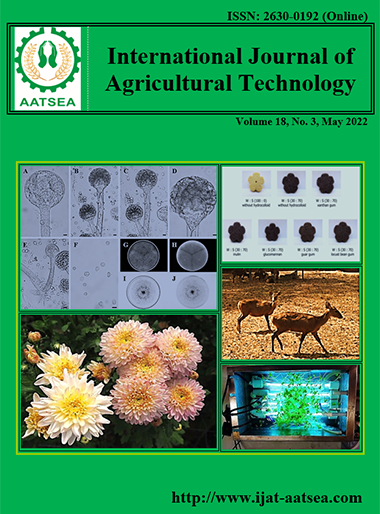Mitochondrial DNA analysis revealed genetic diversity of captive-bred hog deer (Axis porcinus) population in Thailand
Main Article Content
Abstract
Hog deer (Axis porcinus) is an endangered member of the Cervidae family native to South and Southeast Asia. In Thailand, hog deer is nearly extinct in the wild due to unsustainable harvesting and deforestation over the past century. Recent captive breeding program was able to bring the population back to a sustainable level, and a number of hog deer was reintroduced back into the wild. However, due to the small starting number of individuals used at the beginning of the breeding program, there is a risk of genetic bottleneck effect, inbreeding, and loss of genetic diversity. Moreover, two possible subspecies of hog deer exist: Axis porcinus porcinus and Axis porcinus annamiticus. It was unclear which species is the one currently being used for captive breeding effort. The genetic diversity of captive-bred hog deer at nucleotide level was investigated here using the control region of mitochondrial DNA sequences. Overall, 11 haplotypes were identified from 30 individual hog deer at Huaisai Wildlife Breeding Station in Phetchaburi Province, which is one of the original sites of hog deer breeding programs in Thailand. The population still retained some nucleotide diversity and haplotype diversity. Tajima’s D test indicated that the population was expanded in the past. Additionally, phylogenetic analysis revealed that all individuals were identified to be members of the Axis porcinus annamiticus, which is currently the prevalent subspecies in Southeast Asia. The results provided a starting point for further genetic analysis for hog deer conservation programs
Article Details

This work is licensed under a Creative Commons Attribution-NonCommercial-NoDerivatives 4.0 International License.
References
Angom, S., Gupta, S. K., Kumar, A. and Hussain, S. A. (2015). Identification of globally threatened cervids from problematic samples using cytochrome b and control region genes. Conservation Genetics Resources, 7: 647-650.
Angom, S., Kumar, A., Gupta, S. K. and Hussain, S. A. (2017). Analysis of mtDNA control region of an isolated population of Eld’s deer (Rucervus eldii) reveals its vulnerability to inbreeding. Mitochondrial DNA Part B, 2:277-280.
Balakrishnan, C. N., Monfort, S. L., Gaur, A., Singh, L. and Sorenson, M. D. (2003). Phylogeography and conservation genetics of Eld’s deer (Cervus eldi). Molecular Ecology, 12:1-10.
Brook, S. M., Nasak, C. and Channa, P. (2015). Indochinese hog deer Axis porcinus annamiticus on the brink of extinction. Deer Specialist Group News, 27:14-31.
de Jong, M. A., Wahlberg, N., van Eijk, M., Brakefield, P. M. and Zwaan, B. J. (2011). Mitochondrial DNA signature for range-wide populations of Bicyclus anynana suggests a rapid expansion from recent refugia. PLoS One, 6:1-5.
Gupta, S. K., Kumar, A., Angom, S., Singh, B., Ghazi, M. G. U., Tuboi, C. and Hussain, S. A. (2018). Genetic analysis of endangered hog deer (Axis porcinus) reveals two distinct lineages from the Indian subcontinent. Scientific Reports, 8:1-12.
Haanes, H., Markussen, S. S., Herfindal, I., RØed, K. H., Solberg, E. J., Heim, M., Midthjell, L. and Sæther, B. E. (2013). Effects of inbreeding on fitness-related traits in a small isolated moose population. Ecology and Evolution, 3:4230-4242.
Hill, E., Linacre, A. M. T., Toop, S., Murphy, N. P. and Strugnell, J. M. (2017). The complete mitochondrial genome of Axis porcinus (Mammalia: Cervidae) from Victoria, Australia, using MiSeq sequencing. Mitochondrial DNA Part B, 2:453-454.
Hill, E., Linacre, A., Toop, S., Murphy, N. and Strugnell, J. (2019). Widespread hybridization in the introduced hog deer population of Victoria, Australia, and its implications for conservation. Ecology and Evolution, 9:10828-10842.
Ludt, C. J., Schroeder, W., Rottmann, O. and Kuehn, R. (2004). Mitochondrial DNA phylogeography of red deer (Cervus elaphus). Ecology and Evolution, 31:1064-1083.
Mahmut, H., Masuda, R., Onuma, M., Takahashi, M., Nagata, J., Suzuki, M. and Ohtaishi, N. (2002). Molecular Phylogeography of the Red Deer (Cervus elaphus) Populations in Xinjiang of China: Comparison with other Asian, European, and North American Populations. Zoological science, 19:485-495.
Neff, M. M., Turk, E. and Kalishman, M. (2002). Web-based primer design for single nucleotide polymorphism analysis. Trends Genet, 18:613-5.
Park, D. N., Sharma, L. K., Kumar, V. P., Charoo, S. A., Mohan, N. and Goyal, S. P. (2013). Loss of genetic diversity and inbreeding in Kashmir red deer (Cervus elaphus hanglu) of Dachigam National Park, Jammu & Kashmir, India. BMC Research Notes, 6:326.
Pinthong, K., Tanomtong, A., Khongcharoensuk, H., Chaiphech, S., Rattanayuvakorn, S. and Supanuam, P. (2017). Karyotype and Idiogram of Indian Hog Deer (Hyelaphus porcinus) by Conventional Staining, GTG-, High-Resolution and Ag-NOR Banding Techniques. Cytologia (Tokyo), 82:227-233.
Prasanai, K., Sukmasuang, R., Bhumpakphan, N., Wajjwalku, W. and Nittaya, K. (2012). Population characteristics and viability of the introduced hog deer (axis porcinus zimmermann, 1780) in Phu Khieo wildlife sanctuary, Thailand. Songklanakarin Journal of Science and Technology, 34:263-271.
Ramírez-Soriano, A., Ramos-Onsins, S. E., Rozas, J., Calafell, F. and Navarro, A. (2008). Statistical power analysis of neutrality tests under demographic expansions, contractions and bottlenecks with recombination. Genetics, 179:555-567.
Rozas, J., Ferrer-Mata, A., Sanchez-DelBarrio, J. C., Guirao-Rico, S., Librado, P., Ramos-Onsins, S. E. and Sanchez-Gracia, A. (2017). DnaSP 6: DNA sequence polymorphism analysis of large data sets. Molecular Biology & Evolution, 34:3299-3302.
Schnitzler, A., Granado, J., Putelat, O., Arbogast, R. M., Drucker, D., Eberhard, A., Schmutz, A., Klaefiger, Y., Lang, G., Salzburger, W. et al. (2018). Genetic diversity, genetic structure and diet of ancient and contemporary red deer (Cervus elaphus L.) from north-eastern France. PLoS One, 13:1-19.
Williams, R. C. (1989). Restriction Fragment Length Polymorphism. Yearbook of Physical Anthropology, 32:159-184.
Wu, H. L. and Fang, S. G. (2005). Mitochondrial DNA genetic diversity of black muntjac (Muntiacus crinifrons), an endangered species endemic to China. Biochemical Genetics, 43:407-416.
Yang, W., Kang, X., Yang, Q., Lin, Y. and Fang, M. (2013). Review on the development of genotyping methods for assessing farm animal diversity. Journal of Animal Science and Biotechnology, 4:2-7.


